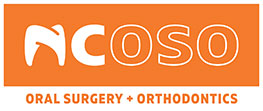In addition to making a beautiful smile and improved self-esteem a reality, orthodontic treatment can treat and prevent a variety of health issues such as tooth decay, bone destruction, gum disease, tooth loss, and digestive challenges.
The costs of orthodontic treatment depend on the type of treatment you receive. Fortunately, dental insurance and flexible financing plans make the fees associated with orthodontics affordable.
Although orthodontic treatment can begin at any age, NCOSO and the American Association of Orthodontists encourage children to visit the orthodontist by age 7. By visiting the orthodontist at an early age, orthodontic related problems can be detected and fixed before they worsen and require surgery.
Once you arrive for your initial orthodontist appointment, we will take some x-rays and thoroughly examine your mouth so that a proper diagnosis can be made. Next, our orthodontist will discuss the necessary treatment while addressing any concerns or answering any questions you may have. Lastly, we will go over the costs of the treatment as well as the payment options we have available.
Yes. About 25% of orthodontic patients are adults. It’s very common for adults to correct issues that they were never able to fix when they were younger. NCOSO welcomes adult patients and looks forward to giving them the attractive smile they deserve. Read more about Adult braces options here.
Invisalign®, clear braces and traditional metal braces are available. After making a proper diagnosis and getting a better understanding of your lifestyle needs and preferences, our orthodontist will recommend Invisalign, clear braces or traditional metal braces.
An oral surgeon is qualified to perform procedures such as tooth extractions, dental implants, wisdom teeth removal, reconstructive oral surgery, and facial, jaw, and tooth injury repairs.
No. Some people may never even develop wisdom teeth. Through regular x-rays and dental exams, your dentist will be able to inform you whether or not your wisdom teeth need to be removed.
The recovery period following wisdom teeth removal varies from patient to patient. In most cases, the initial pain will subside anywhere from a few days to one week. The gums should be completely healed in approximately a month. Your oral surgeon will provide you with directions that will help speed up the recovery process.
Temporomandibular joint and muscle disorders or TMJ are a group of conditions that cause dysfunction and pain in the jaw joint as well as in the muscles that control the movement of the jaw.
If you are interested in scheduling an appointment at NCOSO, please call us or fill out our handy online appointment form. We look forward to helping you or your child achieve a healthy smile.
At NCOSO, we can monitor pulse via pulse ox, oxygen levels via nasal canula, CO2 levels via nasal canula, heart rhythm via EKG, airway via precordial stethoscope, and blood pressure via blood pressure cuff during the entire procedure.
Yes. If patients are using nitrous oxide, we monitor their blood pressure and pulse during the procedure.
Yes. We take patients’ blood pressure and check pulse before we begin to be sure they can undergo surgery. We also check their sugars if they are diabetic and some surgeons will ask that females take a pregnancy test before sedation/nitrous.
We can operate on pregnant women if they are cleared by their OBGYN but may only do local anesthesia. This is determined on a case by case basis.
